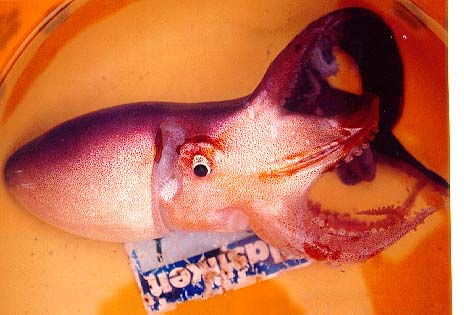
 |
| Home | What's New? | Cephalopod Species | Cephalopod Articles | Lessons | Bookstore | Resources | About TCP | FAQs |
Tremoctopus violaceus, the Blanket Octopus<< Cephalopod Species This is one weird open ocean octopus! It looks like the Batman symbol flying through the ocean. It's common name, Blanket octopus, comes from their large web which they use to glide through the ocean. Blanket octopuses are rarely observed, but when people see them they notice. One, complete with eggs, washed up in Bermuda while I was off island on vacation. It made the local news and was the talk of the island. Another was recently (Sept 2009) spotted in St. Thomas, USVI. Not only do they look weird and shimmer with iridescence, they have an extreme degree of sexual dimorphism. The mature males are tiny compared to the females, just a few centimeters long. Tremoctopus are the most extreme example of sexual size-dimorphism in a non-microscopic animal. The weight of mature males is at least 1:10,000 of mature females. All of the blanket octopuses people typically see, which can be up to 2 meters long, are females. If that wasn't cool enough, Blanket octopuses use the venomous tentacles of cnidarians such as Portuguese man o' war for defense. If you see one of these weird octopuses, please take a picture and let me know when and where. Tremoctopus violaceus lives in the open ocean often in deep water (120-750 m) in the Mediterranean and the North and South Atlantic Ocean. The offspring are likely planktonic given the small size of the eggs. These octopuses may reproduce more than once but no one really knows much about their life history. Excellent images of a related species are here. References and CreditsCreditsPeter Wirtz supplied the photograph of this unusual cephalopod.ReferencesLaptikhovsky and Salman. 2003. On reproductive strategies of the epipelagic octopods of the superfamily Argonautoidea (Cephalopoda: Octopoda). Marine Biology Volume 142, Number 2.NORMAN, PAUL, FINN, TREGENZA. 2002. First encounter with a live male blanket octopus: the world’s most sexually size-dimorphic large animal. New Zealand Journal of Marine and Freshwater Research, 2002, Vol. 36: 733–736 Sweeney, M.J., Roper, C.F.E., Mangold, K.M., Clarke, M.R., and Boletzky, S. v. 1992. 'Larval' and juvenile cephalopods: a manual for their identification. Smithsonian Contributions to Zoology - No. 513. Thomas. 1977. Systematics, Distribution, and Biology of Cephalopods of the Genus Tremoctopus (Octopoda: Tremoctopodidae) Bulletin of Marine Science, Volume 27, Number 3, July 1977 , pp. 353-392(40)
| ||||||
| Home | What's New? | Cephalopod Species | Cephalopod Articles | Lessons | Resources | About TCP | FAQs | Site Map | |
 |
The Cephalopod Page (TCP), © Copyright 1995-2025, was created and is maintained by Dr. James B. Wood, Associate Director of the Waikiki Aquarium which is part of the University of Hawaii. Please see the FAQs page for cephalopod questions, Marine Invertebrates of Bermuda for information on other invertebrates, and MarineBio.org and the Census of Marine Life for general information on marine biology. |